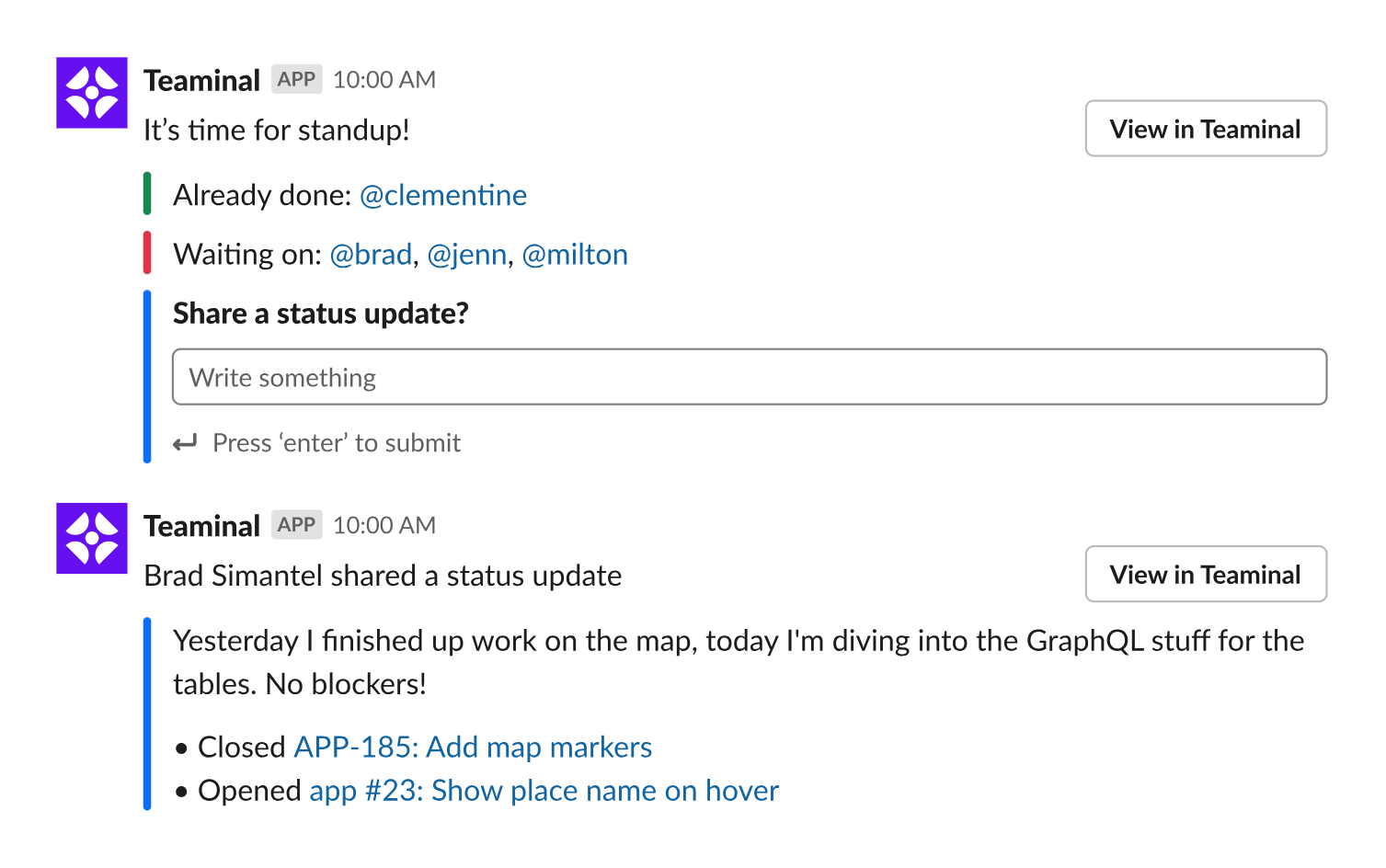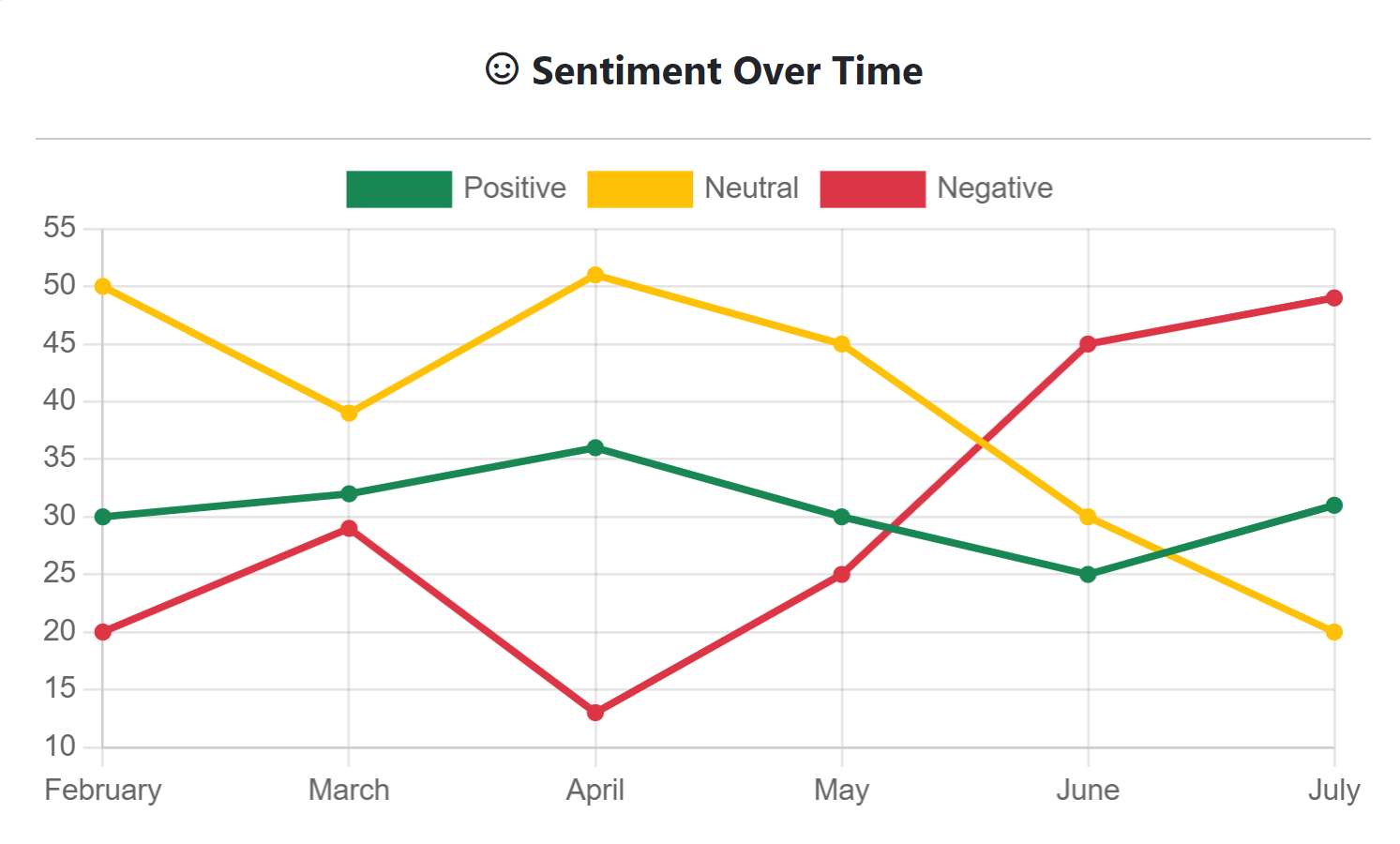Helpful Summary
- Overview: We do a deep dive on daily standup meetings, covering what they are, why they’re so important to Agile, and how you can make them more fun, productive, and effective.
- Why trust us: We’ve helped hundreds of high-performing teams at companies like Hello Fresh, Angi, and T-Mobile do Agile better with tools for async retros, backlog refinement, and daily standups.
- Why this is important: Daily standups are a powerful tool for boosting alignment and collaboration within Agile teams, but a lot of teams aren’t taking the best approach to get the most out of them.
Wondering How to Optimize Daily Standups?
Daily standup meetings are the heartbeat of Agile teams and the cornerstone of effective communication and collaboration. But a lot of Agile teams struggle to get them right—and a poorly executed daily standup can actually do more harm than good.
We’ll explain why later—because in this Teaminal article, we’re diving into the nitty-gritty of mastering your daily standup meeting. From tools to processes, we’re breaking down the key components that will help you optimize your team’s daily standups and achieve maximum productivity.
But first…
Why Listen to Us?
At Teaminal, we pride ourselves on being trusted by industry-leading companies like IKEA, T-Mobile, Workday, and Medium.

Our track record of offering innovative solutions for remote team collaboration speaks for itself. With Teaminal, distributed teams experience Agile’s benefits without sacrificing hours of development time for meetings and check-ins.
The bottom line? We know a thing or two about making daily standups successful.
What Is a Daily Standup Meeting?
Let’s start simple.
A daily standup meeting (also known as a daily scrum) is a quick, check-in that happens at the same time every day. It’s an opportunity for the team to sync up, share progress, and identify any roadblocks or issues that need attention.
The name “standup” comes from the idea that everyone stands during the meeting to keep things moving quickly. This obviously isn’t required—but it’s a nice reminder that the focus of this meeting is quick, concise communication.
During a daily standup meeting, each team member answers three key questions:
- What did I accomplish yesterday?
- What am I working on today?
- Are there any obstacles or challenges blocking my progress?
Daily standups are traditionally synchronous meetings (either virtual or in-person) that last 15–20 minutes. But with an async Agile standup tool like Teaminal, team members can post their updates and responses to each other’s updates at any time (via Slack or our web app).

This saves hours each week and offers tons of additional benefits that we’ll get into later.
Example Daily Standup Scenario
One of your colleagues presents in daily standup. They mention that they’re working on an API integration for a new feature and that their only blocker is that they don’t have access to the API documentation.
You happen to know that another team in the company has already done a similar integration and has access to the documentation. You share this information, and they contact the other team—now they can continue making progress.
Benefits of Daily Stand-Up Meetings
Better Alignment
Alignment is a bit of a buzzword. But it’s the best way to succinctly sum up the benefits of a daily standup.
The idea is pretty simple—when you know what other people are working on, you can better focus your attention where it matters most. You can avoid duplicate work, help others solve problems, ask the right questions to the right people, and feel like you’re part of a cohesive team.
All of these lead to higher (and higher-quality) output.
Better Team Management
Without daily standups, the job of POs and PMs becomes incredibly difficult—constant DMs, occasional emails, and never quite knowing how someone’s day is going. Daily standups are a simple, effective solution.
To give an example, imagine a scenario where a daily standup reveals that no one is currently working on a keystone feature for an upcoming project. This knowledge allows the PO to assign a team member to that task quickly.
Better Communication
Last but not least, daily standups improve communication within a team.
It’s easy for teams (especially remote teams) to fall into siloed work patterns. You’re busy focusing on your tasks and may not even realize that someone on the team is struggling or has key information that could help you.
Daily standups address this in two ways. The first is by forcibly breaking down these siloes once a day, and the second is by (slowly but surely) making open communication a habit.
How to Make Your Daily Stand-Up Meetings More Productive
Want to unlock the benefits listed above? You’ll need the right approach to daily standups.
Here are a few tips to make your meetings more productive and effective:
1. Think About Going Async
Synchronous standups can be an important (and beneficial) part of a team’s workflow. Or they can be an unnecessary time-sink that the team secretly hates. In that latter case, it may be worth considering going async.
What does an async daily standup meeting look like? If you’re using Teaminal, it looks like a thread in your Slack channel.

We send an automated message daily and tag everyone who needs to participate. When they log in for the day, they can respond to the message with their plans and progress, and issues they’ve closed in the last 24 hours will automatically be included.
This approach has a few advantages:
- Less wasted time: With Teaminal’s async standups, you recover about an hour and 15 minutes of development time per team member weekly (15 min. x 5 days per week). For a team of 5, you save up to 294 hours per year—that’s like hiring an extra developer for 2 months!
- Better organization: Our async standups are organized into comment threads. You can refer back to them whenever you want, add input, search for specific items, and more. Plus, reminders are automated, so you don’t need to chase anyone down.
- Easier scheduling: Organizing synchronous meetings across time zones can be a hassle—especially since daily standups happen in the morning. With Teaminal’s async standups, team members can respond at their convenience.
2. Rotate Meeting Roles
If you hold synchronous standup meetings, there are a few roles you’ll (probably) need to fill:
- Facilitator: This person is responsible for running the meeting. They ensure everyone has a turn to speak, ask follow-up questions if necessary, and keep the meeting on track.
- Notetaker: This person takes notes during the meeting and shares them with the team afterward. With an async tool like Teaminal, this part is automated but often overlooked at synchronous meetings.
- Tech troubleshooter: This person sets up any and all tech needed for the meeting—whether that’s circulating a Zoom link or setting up a projector and microphone.
If you haven’t filled these roles already, our first tip is to start there. But beyond that, we also suggest rotating these roles to allow everyone to participate differently. This shares the burden between everyone on the team and also gives everyone a chance to practice different skills.
3. Track Participation (and Sentiment)
Whether your meetings are sync or async, you should be tracking participation and sentiment.
This can be done in a few different ways, but one of the most effective methods is to have someone take notes during the meeting and mark down who is speaking and if their contributions are positive, negative, or neutral.
Another way to track participation is to use polling or surveys before and after the meeting. This allows team members to share their thoughts and ideas anonymously, which can encourage more honest feedback.
With Teaminal, it’s even easier.

Our Agile reporting suite lets POs and PMs get a high-level view of each team’s engagement and sentiment. Sentiment charts help you spot positive or negative trends, word clouds help you understand what your team is thinking, and participation charts help you identify who is contributing the most.
4. Incorporate Gamification
Here’s how you can effectively incorporate gamification techniques:
- Points System: Implement a points system where team members earn points for contributions, helpful follow-up questions or clarifications, answering questions, and generally embodying the spirit of daily standups and Agile.
- Team Challenges: Introduce team challenges or missions related to daily standups—like achieving a certain number of points, overcoming a certain number of blockers in real-time, or completing tasks related to the daily standup process.
The idea is to make your daily standups more fun and engaging, while also encouraging team members to actively participate and contribute.
5. Encourage Feedback and Suggestions
Create an open environment where team members feel comfortable providing feedback and suggesting improvements. This could be about the daily standup process itself or any other aspect of the team’s work.
Closing the feedback loop is important here. Make sure employees know you’re listening and actively taking their suggestions into consideration. Give them updates about what you’re doing to address their feedback.
6. End with a Positive Note
Wrap up the stand-up meeting positively by expressing gratitude or recognition for team members’ efforts. This could be as simple as acknowledging individual contributions or expressing confidence in the team’s ability to overcome challenges together.
Ending the meeting on a high note leaves everyone feeling motivated and encouraged.
Conclusion
Mastering your daily stand-up meetings requires a combination of structure, engagement, and adaptability.
By following the step-by-step guide outlined here, you can transform your stand-up meetings into efficient, effective, and even enjoyable sessions that drive productivity and foster collaboration within your team.
Teaminal is a versatile tool designed for remote teams. It enables asynchronous collaboration and streamlines stand-up meetings, retrospectives, and sprint planning.




